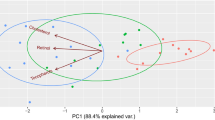Abstract
The present study was undertaken to determine whether decreases in fat contents result in lower vitamin E contents. Milk samples of varying fat contents (half and half, whole milk, reduced-fat milk low-fat milk, and nonfat milk) were obtained from a local dairy on six different occasions, α-locopherol was the major form of vitamin E (>85%); γ-tocopherol and α-tocotrienol were present to a lesser extent. As the fat contents of milk products decreased from 11 to 0.3%, the vitamin E contents decreased. For example, raw milk as compared to nonfat milk had both higher α-tocopherol contents (45.5+-4.6 vs. 4.5±0.5 μg/100 g; P<-0.0001) and higher total lipids ( 3.46±0.49 vs. 0.30±0.07 g/100 g; P≤0.0001). Vitamin E, cholesterol, and total lipids increased as cream was added back to nonfat milk during production. For every 1 mg cholesterol increase, there was an increase of approximately 4 μg of α-tocopherol; for every 1 g total lipids increase, the α-tocopherol content increased by 17 μg. These data demonstrate that removal of milk fat markedly decreases the vitamin E content of various milk products
Similar content being viewed by others
Abbreviations
- FDA:
-
Food and Drug Administration
- HPLC:
-
high-performance liquid chromatogrpahy
- MI:
-
myocardial infarction
References
Kushi, L.H., Folsom, A.R., Prineas, R.J., Mink, P.J., Wu, Y., and Bostick, R.M. (1996) Dietary Antioxidant Vitamins and Death from Coronary Heart Disease in Postmenopausal Women, N. Engl. J. Med. 334, 1156–1162.
Knekt, P., Reunanen, A., Jarvinen, R., Seppanen, R., Heliovaara, M., and Aromma, A. (1994) Antioxidant Vitamin Intake and Coronary Mortality in a Longitudinal Population Study, Am. J. Epidemiol. 139, 1180–1190.
Rimm, E.B., Stampfer, M.J., Ascherio, A., Giovannucci, E., Colditz, G.A., and Willett, W.C. (1993) Vitamin E Consumption and the Risk of Coronary Heart Disease in Men. N. Engl. J. Med. 328, 1450–1456.
Stampfer, M.J., Hennekens, C.H., Manson, J.E., Colditz, G.A., Rosner, B., and Willett, W.C. (1993) Vitamin E Cousumption and the Risk of Coronary Disease in Women, N. Engl. J. Med. 328, 1444–1449.
Stephens, N.G., Parsons, A., Schofield, P.M., Kelly, F., Cheeseman, K., and Mitchinson, M.J. (1996) Randomized Controlled Trial of Vitamin E in Patients with Coronary Disease: Cambridge Heart Antioxidants Study, Lancet 347, 4781–4786.
(1999) Dietary Supplementation with n−3 Polyunsaturated Fatty Acids and Vitamins E After Myocardial Infarction: Results of the GISSI-Prevenzione Trial, Lancet 354, 447–455.
Jialal, I., Devaraj, S., Huet, B.A., and Traber, M.G. (2000) GISSI-Prevenzione Trial, Lancet 354, 1554.
Yusuf, S., Dagenias, G., Pogue, J., Bosch, J., and Sleight, P. (2000) Vitamin E Supplementation and Cardivascular Events in High-Risk Patients. The Heart Outcomes Prevention Evaluation Study Investigators, N. Engl. J. Med. 342, 154–160.
Boaz, M., Smetana, S., Weinstein, T., Matas, Z., Gafter, U., Iaina, A., Knecht, A., Weissgarten, Y., Brunner, D., et al. (2000) Secondary Prevention with Antioxidants of Cardiovascular Disease in Endstage Renal Disease (SPACE): Randomised Placebo-controlled Trial, Lancet 356, 1213–1218.
Podda, M., Weber, C., Traber, M.G., and Packet, L. (1996) Simultaneous Determination of Tissue Tocopherols Tocotrienols, Ubiquinols, and Ubiquinones, J. Lipid Res. 37, 893–901.
Bligh, E.G., and Dyer, W.L. (1959) A Rapid Method of Total Lipid Extraction and Purification, Can. J. Biochem. Physiol. 37, 911–917.
Lehmann, J., Martin, H.L., Lashley, E.L., and Judd, J.T. (1986) Vitamin E in Foods from High and Low Linoleic Acid Diets, J. Am. Diet. Assoc. 86, 1208–1216.
Food and Nutrition Board, Institute of Medicine (2000) Dietary Reference Intakes for Vitamin C, Vitamin E, Selenium, and carotenoids, pp. 506, National Academy Press, Washington, DC.
Sheppard, A.J., Pennington, A.T., and Weihrauch, J.L. (1993) Analyses and Distribution of Vitamin E in Vegetable Oils and Foods, in Vitamin E in Health and Disease (Packer, L., and Fuchs, J., eds.), pp. 9–31, Marcel Dekker, Inc., New York.
Ma, J., Hampel, J.S., and Betts, N.M. (2000) Antioxidants Intakes and Smoking Status: Data from the Continuing Survey of Food Intakes by Individuals 1994–1996, Am. J. Clin. Nutr. 71, 774–780.
Retzlaff, B.M., Walden, C.E., McNeney, W.B., Buck, B.L., Mc-Cann, B.S., and Knopp, R.H. (1997) Nutritional Intake of Women and Men on the NCEP Step I and Step II Diets, J. Am. Coll. Nutr. 16, 52–61.
Jensen, R.G., Ferris, A.M., Lammi-Keefe, C.J., and Henderson, R.A. (1990) Lipids of Bovine and Human Milks: A Comparison, J. Dairy Sci. 73, 223–240.
ESHA Research (1995) The Food Processor, v6.01, Salem.
Weimann, B.J., and Weiser, H. (1996) Functions of Vitamin E in Reproduction and in Prostacyclin and Immunoglobulin Synthesis in Rats, Am. J. Clin. Nutr. 53, 1056s-1060s.
Suarna, C., Hood, R.L., Dean, R.T., and Stocker, R. (1993) Comparative Antioxidant Activity of Tocotrienols and Other Natural Lipid-soluble Antioxidants in a Homogenous System, and in Rat and Human Lipoproteins, Biochim. Biophys. Acta 1166, 163–170.
Serbinova, E.A., Tsuchiya, M., Goth, S., Kagan, V.E., and Packer, L. (1993) Antioxidant Activity of α-Tocopherol and α-Tocotrienol in Membranes, in Vitamin E in Health and Disease (Packer, L., and Fuchs, J., eds.), pp. 235–243, Marcel Dekker, Inc., New York.
Kamat, J.P., Sarma, H.D., Devasagayam, T.P., Nesaretnam, K., and Basiron, Y. (1997) Tocotrienols from Palm Oil as Effective Inhibitors of Protein Oxidation and Lipid Peroxidation in Rat Liver Microsomes, Mol. Cell. Biochem. 170, 131–137.
Bauernfeind, J. (1980) Tocopherols in Food, in Vitamin E. A Comprehensive Treatise (Machlin, L.J., ed.), pp. 99–167, Marcel Dekker, Inc., New York.
Varnam, A.H., and Sutherland, J.P. (1994) Milk and Milk Products: Technology, Chemistry and Microbiology, in Food Products Series, pp. 451: Chapman & Hall, London.
Enns, C.W., Goldman, J.D., and Cook, A. (1997) Trends in Food and Nutritient Intakes by Adults: NFCS 1977–1978, CSFII 1989–91 and CSFII 1994–95, Family Econ. Nutr. Rev. 10, 2–15.
Ballew, C., Keuster, S., Serdula, M., Bowman, B., and Dietz, W. (2000) Nutrient Intakes and Dietary Patterns of Young Children by Dietary Fat Intakes, J. Pediatr. 136, 181–187.
Author information
Authors and Affiliations
About this article
Cite this article
Kaushik, S., Wander, R., Leonard, S. et al. Removal of fat from Cow's milk decreases the vitamin E contents of the resulting dairy products. Lipids 36, 73–78 (2001). https://doi.org/10.1007/s11745-001-0670-3
Received:
Revised:
Accepted:
Issue Date:
DOI: https://doi.org/10.1007/s11745-001-0670-3




